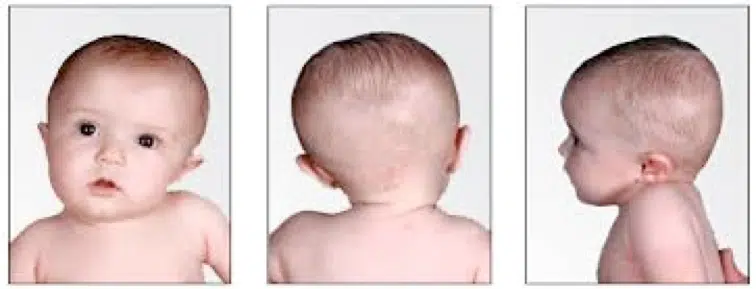Plagiocephaly is a term used to describe a baby’s flat or misshapen head shape, which may also include the ears and face. It does not affect the development of the baby’s brain, but if it is not treated it may affect a baby’s physical appearance by causing uneven growth of their face and head.
The most common form is positional plagiocephaly. It occurs when a baby’s head develops a flat spot due to pressure on that area. Babies are more vulnerable because their skull is soft and pliable when they’re born.
Positional plagiocephaly typically develops after birth when babies spend time in a position that puts pressure on one part of the skull. Babies should always sleep on their backs as per the Safe Sleeping Guidelines at rednose.com.au.
Signs of Positional Plagiocephaly
Many vaginally delivered babies are born with an oddly shaped head caused by the pressure of passing through the birth canal. This usually corrects itself within about six weeks. If your baby’s head hasn’t rounded out by six weeks or you notice the following;
- A flat area on your baby’s head. This is usually on one side and or the back of the head. A head preference to one side may develop.
- One side of the forehead is further forward than the other.
- One ear is further forward than the other.

Babies with a torticollis can also develop a plagiocephaly. A Torticollis is when a tight or shortened muscle on one side of the neck causes the head to tilt to the side.

Babies with a torticollis or those who develop neck tightness due to a head preference will need physiotherapy to help stretch out their tight muscles.
When to be Concerned About a Flat Spot on Your Baby’s Head
Everyone’s skull is a bit asymmetrical. In many cases, a flat spot on a baby’s head will round out on its own around 6 months of age, as they start moving and sitting. However, if you notice flattening of your baby’s head at any time, don’t wait. A baby’s skull becomes less soft and pliable as they grow. The younger your baby is, the easier it will be.
Tips:
- Regularly change your baby’s position to avoid putting pressure on the flattened area of the head.
- Bedtime and naps: Remember SIDS recommendations back to sleep. During sleep times, alternate the direction your baby’s head is facing when you put them to sleep.
- Feeding time: Alternate sides whenever you feed your baby a bottle.
- Sitting time: Avoid leaving your baby for long periods of time in a car seat, rocker, baby swing where their head is likely to rest on the same spot.
- Tummy time: During waking hours, supervised tummy time is essential for the development of motor skills. Tummy time also helps prevent plagiocephaly by strengthening neck muscles and is a great position to take pressure off their head. Tummy time usually takes time for a baby to get used to, so persevere!
If you have any concerns regarding your baby’s head shape come we recommend seeing a paediatric physiotherapist.

